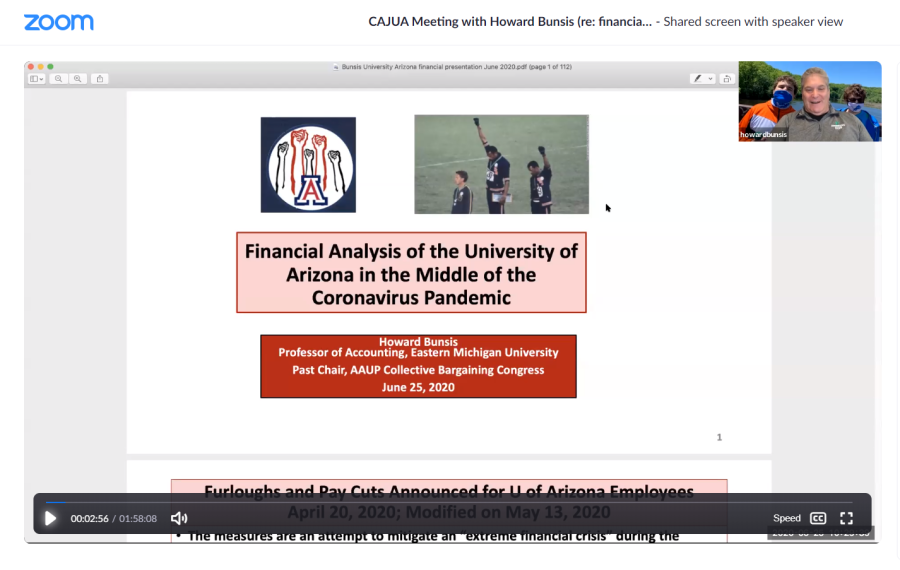The Coalition for Academic Justice at UArizona held two events over Zoom Thursday, June 25, the first being a webinar where an out-of-state professor was brought in to give an analysis of the UA’s finances and the second was a general assembly to have a vote on delaying the current furlough plan.
RELATED: Campus reentry update: Current COVID-19 stats, what it means for campus reentry
The financial seminar
The webinar started at 10:30 a.m. and was titled “The Real Scoop: An Independent Analysis of the UA’s Current Financial Situation.” The main speaker of the event was Howard Bunsis, a professor of accounting from Eastern Michigan University.
Bunsis said he has given many presentations such as this one, where he analyses a college’s financial data and then explains it to faculty and students of that college.
Toward the beginning of the presentation, Bunsis said from his research, he thinks the UA would have financial losses due to COVID-19, but not enough to call it a financial crisis and not enough to justify furloughing and laying off faculty and staff.
Bunsis said that the UA has a AA bond rating. The-letter based rating system ranges from “AAA” to “BBB-,” according to Investopedia, and shows the creditworthiness of a bond.
Bunsis said the reason the official UA financial statement shows the university has unrestricted negative reserves is because in 2015, many university administrators put pension liabilities on their balance sheets. He also found that the UA has over $800 million in unrestricted assets.
“This situation is exactly what reserves should be used for,” Bunsis said.
Bunsis said that by UA guidelines, $132 million of those assets are unexpendable and therefore cannot be used. Another $28 million are used for student loans and $230 million can be used as reserves for workers’ salaries.
Bunsis said he used the primary reserve ratio, which he said is the total reserves compared to total expenses, to find that the UA has enough reserves to cover 5.8 months of expenses.
“I’m not saying that there’s a big pot of cash sitting in the president’s office,” Bunsis said. “But I am saying … is that they have almost one-and-a-half billion of cash in investments. The reserves, the unrestricted reserves, are about $800 million. That tells me that these reserves are not just tied up in something, they have liquidity. They can tap into these reserves if they want to.”
Bunsis estimated a worst-case and best-case scenario for tuition losses for the UA; the worst-case scenario would be a 13% loss in tuition and best-case scenario would be a 5% loss. He estimated the UA’s losses will be about $100 million.
“Even if you take the administration of losses, my worst case combining the two years, the unrestricted reserves easily cover,” Bunsis said. “I’m not saying they can write one big check, but it gives them a flexibility to use the reserves and to borrow against them instead of laying people off and destroying lives.”
General assembly
The general assembly started at 2 p.m. and was led by Chair of the Faculty Jessica Summers, an associate professor in the Department of Teaching, Learning and Sociocultural studies.
Only General Faculty were allowed to vote.
CAJUA member and associate professor in the School of Journalism Celeste González de Bustamante spoke next.
“We are at a historical moment on our campus,” Bustamante said. “Just two months ago, the Coalition for Academic Justice was formed as a campuswide group comprised of graduate students, staff and faculty from 10 colleges across our campus. The coalition gathered shortly after the UA administration’s financial stability plan was released on Friday, April 17, because so many of us were concerned that this financial plan was poised to inflict irreversible damage to our university’s core mission of teaching, research and service.”
Russ Toomey, a CAJUA member and associate professor in the School of Family Studies and Consumer Sciences, said that according to studies done by the Pew Research Center published in The New York Times, for those making $40,000 to $60,000 a year, it would take two years to save just one month’s worth of living expenses.
Toomey said the UA’s furlough plan would take 4,000 employees off pay who make $40,000 to $60,000 a year.
The first vote in the assembly was to vote to put the ballot forward. If the ballot was voted forward, then the ballot would decide whether to delay the furlough plan.
Only General Faculty were allowed to vote, and of the 675 votes that were cast for the first voting, 633 were yes, pushing the ballot forward, 35 were no and 7 were abstained.
Therefore, the second voting continued, but General Faculty members were given 24 hours to cast their vote on whether they think the furlough period should be postponed to mid-September 2020.
Of the 1,462 people who voted, 1,305 were in favor of delaying, 128 voting no and 29 abstaining. This marks an official faculty recommendation to UA administration to delay the implementation of the current furlough plan.
On Wednesday, July 1 2020, an email was sent by the UA written by UA Chief Financial Officer Lisa Rulney, who said that the university does not have a reserve fund of $806 million.
According to Rulney, the UA’s unrestricted net assets are actually what the university uses for day to day expenses such as utilities, facility maintenance and travel.
Rulney said that in a 12 month period, to June 26, 2020, the UA went from $824 million in operating cash to $699 million.
Editor’s note: This article has been updated with the results of the General Faculty vote and information from Chief Financial Officer Lisa Rulney.
Follow Jake Toole on Twitter









